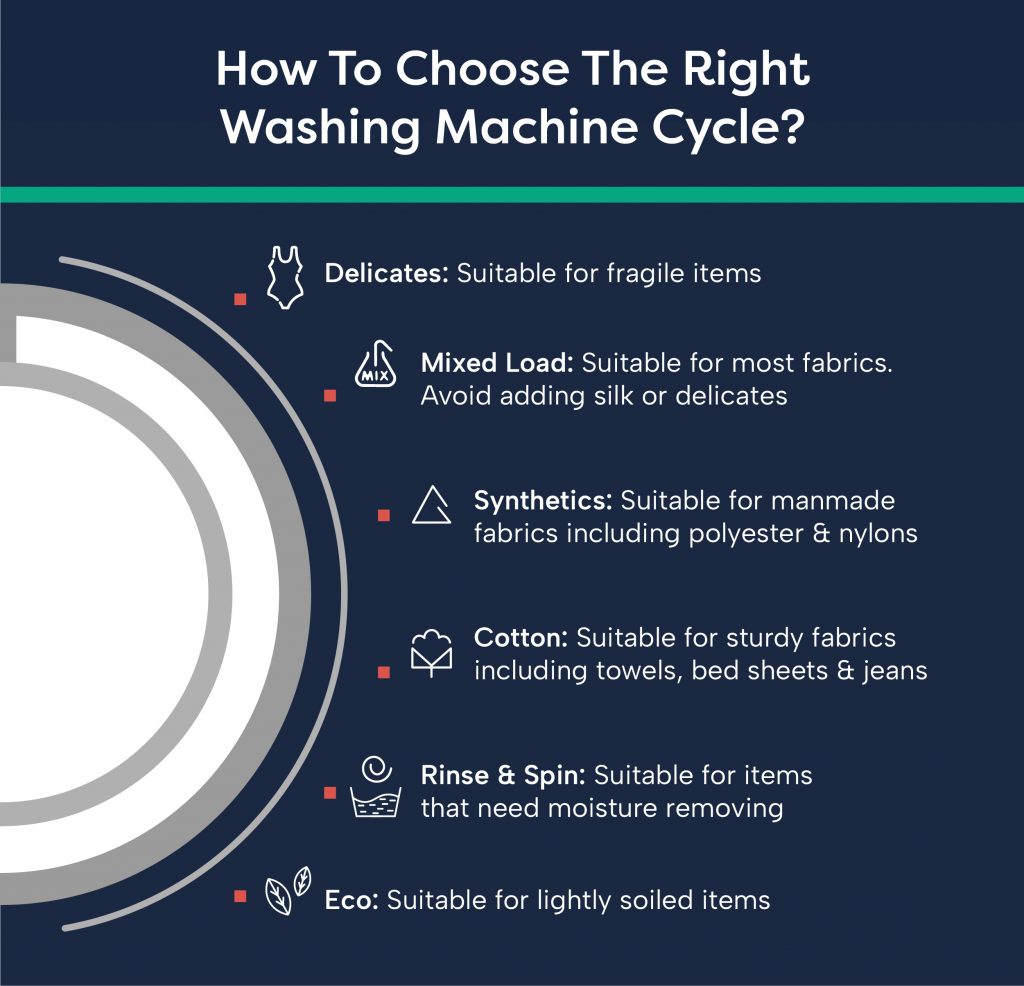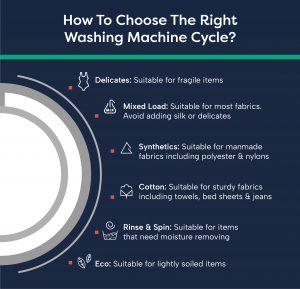Help & Advice
Help & Advice: Washing Machine Cycles Explained
Washing Machine Cycles Explained
Most modern washing machines boast a vast array of wash cycles, but with so many different dials, symbols and buttons, choosing the right one can seem like a minefield. Whilst you may be tempted to just pop everything on a quick wash and hope for the best, particularly if your dirty laundry is piling up, this can affect the condition of both your clothes and your machine over time.
How to Choose The Right Washing Machine Cycle?
Washing your clothes shouldn’t be a complicated process; that’s why the experts at Pacifica have written this guide explaining common washing machine cycles and how to choose the correct one.*

Cotton
A cotton cycle is usually considered to be a ‘normal’ wash. It uses a rapid spin speed and a lengthy cycle time to remove stains and dirt from everyday cotton garments. Due to its high agitation, it is perfect for towels, bedsheets and more. However, it is not recommended for more delicate items.
Permanent press
Unlike most other washing machine cycles, there are no clues in the name to help you determine just what the permanent press cycle does, therefore, you may ignore it if you’re not sure what function it serves. The permanent press cycle can help to reduce wrinkles by using warm water and a slower spin speed. It is perfect for clothes that wrinkle easily, such as T-shirts, button-down shirts and clothes that can’t be ironed. Whilst it is a gentler cycle, it is not an appropriate substitute for a delicates wash.
Delicates/Wool
As the name implies, a delicates or wool cycle is typically the most gentle setting, using low agitation, cool water and a low spin speed to prevent your fragile clothes from becoming damaged. It is ideal for silk items, lingerie, woollen clothes and more.
Sports
If you exercise regularly, your activewear is probably among the most frequently washed items in your wardrobe. If your washing machine is equipped with a sports cycle, this is the most suitable setting for washing your gym gear as it uses slow spin speeds and lower temperatures to thoroughly wash and remove any sweat marks or odours.
Eco wash
With energy bills on the rise again, you’re likely looking for ways to make your washing machine more energy efficient. An eco wash does just that by using less water, lower temperatures and a longer cycle time to result in a more energy-efficient wash. In fact, a recent study found that switching to an eco-wash yielded energy savings of between 35% and 59%!
Synthetics
Many washing machines nowadays are equipped with a synthetics setting, which uses medium agitation and a low spin speed. This cycle can handle all everyday non-cotton clothing, such as items made from polyester, nylon and acrylic-blended yarn.
Rinse and spin
A washing machine cycle typically has five phases:
- Pre-wash
- Main wash cycle
- Rest period
- Rinse
- Spin
As the name implies, a rinse and spin cycle eliminates the first three phases and simply rinses the clothes before spinning the water out with no detergent required. The load will be spun at an extremely high speed, making it ideal for any clothes that retain excess moisture. If you have sensitive skin or allergies, you may want to use this cycle after a wash to remove any detergent residue.
Quick wash
We’ve all been there — you’ve just realised your favourite outfit is dirty when you’d planned to wear it tomorrow. For situations where the laundry just can’t wait and you need to complete a wash immediately, a quick wash is ideal. Although the duration of a quick wash varies between machines, most cycles will be under 40 minutes. This setting typically includes a shorter main wash coupled with a higher spin cycle. However, it is not best suited for heavily soiled clothes as it may not be able to remove stubborn stains.
Bulky/Heavy-duty
A bulky or heavy-duty cycle is best suited for larger items, such as coats, blankets, small rugs, pillows and more. It is typically a longer cycle that uses extra soaking time and a higher volume of water to ensure all sturdy items are washed sufficiently. This setting can also be used on heavily soiled clothing to remove any stubborn stains.
Which temperature should I wash my clothes on?
It’s not only the correct washing cycle that you need to choose, you’ll also need to select the most suitable temperature for your garments. Most washing machines have three available temperature settings:
- Hot wash (60°C and above): A hot wash is tough on stains and germs, making it the best option for fabrics that have been heavily soiled or contain a high level of bacteria, such as clothes worn by somebody who has recently been ill.
- Warm wash (40°C): Any clothing that has been in contact with bodily oils, such as gymwear, underwear and everyday clothing, should be washed on a warm wash of at least 40°C.
- Cold wash (30°C and below): Any delicate items should be washed on a cold wash to protect the fabric. It’s also a good idea to wash any brightly coloured clothing on a cold wash to prevent them from fading or transferring the dye.
How to choose the right wash cycle
What is the best wash cycle for bedding?
As your bedsheets are heavily used, it’s best to put them on a longer cycle. Usually, a regular cotton cycle will suffice; however, if your bedsheets are made from a different fabric, such as silk or flannel, then they may require a gentler wash. Your bedding should be washed at the highest temperature that is appropriate for the fabric.
What is the best wash cycle for towels?
As your towels come into contact with bodily oils, it’s best to wash them on a hot wash with a longer cycle to remove any germs — a regular cotton cycle or even a heavy-duty cycle will work best.
What is the best wash cycle for jeans?
As a general rule of thumb, your jeans should be washed separately on a cold, gentle cycle — ideally, a delicates wash but you could also use the cotton cycle. This will prevent the denim from fading and shrinking to ensure your jeans stay in good condition for longer.
What is the best wash cycle for trainers?
You may not realise it, but your washing machine offers a quick and convenient way to clean your trainers. It’s best to first remove the laces and scrub any loose dirt before popping them in a mesh bag to prevent any snags. Then, select a cold wash with a low spin speed, such as a delicates wash.
*This article is only guidance — you should always check the care label on all items before washing to guarantee the best results.
In order for your washing machine to operate efficiently on all wash cycles, it’s important that any potential issues are identified and repaired as quickly as possible. Here at Pacifica, we offer swift and cost-effective washing machine repairs to customers all across the UK. Our team of engineers boast years of industry experience and can perform repairs on all major appliance brands.
Get in touch with us today to obtain a quote or arrange your repair work.

